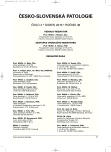An Autopsy Case of Carbamazepine Poisoning
Pitevní nález otravy carbamazepinem
Autoři presentují případ smrtelné otravy carbamazepinem. Kvantitativní analýza otravy carbamazepinem vysoce výkonnou kapalinovou chromatografií stanovila koncentraci carbamazepinu v krvi z femorální žíly 50,2 μl/l, respektive 60,3 μg/l v krvi odebrané ze srdečního svalu, a mnoho nevstřebaných tablet bylo také nalezeno v žaludečním obsahu. Stanovili jsme, že příčinou smrti bylo předávkování carbamazepinem.
Klíčová slova:
carbamazepin – otrava – vysoce výkonná kapalinová chromatografie
Authors:
Hiroshi Kinoshita *; Kimiko Morikawa **; Azumi Kuze ***; Yasushi Nagasaki **; Motonori Takahashi ****; Minori Nishiguchi ****; Hajime Nishio ****; Yasuhiro Ueno ***; Mostofa Jamal *; Yusuke Kubo *; Naoko Tanaka *; Kiyoshi Ameno *
Authors‘ workplace:
Department of Forensic Medicine, Faculty of Medicine, Kagawa University, 1750-1, Miki, Kita, Kagawa, 761-0793, Japan
*; Hyogo Medical Examiners Office, Arata-cho 2-1-31, Hyogo-ku, Kobe, 652-0032, Japan
**; Division of Legal Medicine, Department of Environmental Health and Safety, Kobe University Graduate School of Medicine, 7-5-1, Kusunoki-cho, Chuo-ku, Kobe, 650-0017, Japan
***; Department of Legal Medicine, Hyogo College of Medicine, 1-1, Mukogawa-cho, Nishinomiya, Hyogo, 663-8501, Japan
****
Published in:
Soud Lék., 55, 2010, No. 2, p. 22-24
Overview
We present a case of fatal carbamazepine poisoning. Quantitative analysis of carbamazepine using high performance liquid chromatography, revealed that the concentrations of carbamazepine were 50.2 μg/ml in the femoral venous blood and 60.3 μg/ml in the heart blood, respectively, and many unabsorbed tablets were also observed in the stomach contents. We concluded that the cause of death was due to carbamazepine overdose.
Key words:
carbamazepine – poisoning – high performance liquid chromatography
All correspondence concerning this paper should be addressed to:
Dr. H. Kinoshita,
Department of Forensic Medicine, Faculty of Medicine, Kagawa University,
1750-1, Miki, Kita, Kagawa, 761-0793, Japan
TEL: +81-87-891-2140
FAX: +81-87-891-2141
e-mail: kinochin@med.kagawa-u.ac.jp
Sources
1. Baselt RC. Carbamazepine. In: Baselt RC editor. Disposition of toxic drugs and chemicals in man, (5th ed). Foster City, CA: Chemical Toxicology Institute, 2000, pp. 126-129.
2. Baselt RC. Phenobarbital. In: Baselt RC editor. Disposition of toxic drugs and chemicals in man, (5th ed). Foster City, CA: Chemical Toxicology Institute, 2000, pp. 689-691.
3. Hojer J, Malmund H-O, Berg A. Clinical features in 28 consecutive cases of laboratory confirmed massive poisoning with carbamazepine alone. J Toxicol Clin Toxicol 1993; 31 : 449-458.
4. Japan poison information center. 2008 annual report by Japan poison information center. Chudoku Kenkyu 2009; 22 : 137-168.
5. Kinoshita H, Taniguchi T, Kubota A, Nishiguchi M, Ouchi H, Minami T, Utsumi T, Motomura H, Nagasaki Y, Ameno K, Hishida S. An autopsy case of imipramine poisoning. Am J Forensic Med Pathol 2005; 26 : 271-274.
6. Kinoshita H, Nishiguchi M, Kasuda S, Takahashi M, Ouchi H, Minami T, Matsui K, Yamamura T, Motomura H, Ohtsu N, Yoshida S, Adachi N, Ohta T, Komeda M, Ameno K, Hishida S. Forensic toxicological implication of an autopsy case of mixed drug overdose involving clomipramine, chlorpromazine and flunitrazepam. Soud Lek. 2008; 53 : 28-30.
7. Löscher W, Potschka H. Role of multidrug transporters in pharmacoresistance to antiepileptic drugs. J Pharmacol Exp Ther. 2002; 301 : 7-14.
8. McNamara JO. Pharmacotherapy of the Epilepsies. In: Brunton LL, Lazo JS, Parker KL. eds. Goodman & Gilman’s The pharmacological basis of therapeutics (11th ed). New York: McGraw-Hill; 2006, pp. 501-526.
9. Moffat AC, Osselton MD, Widdop B, editors. Carbamazepine. In: Clark’s analysis of drug and poisons, 3rd edition. London, Chicago: Pharmaceutical Press; 2004. p. 747-749.
10. Moffat AC, Osselton MD, Widdop B, editors. Phenobarbital. In: Clark’s analysis of drug and poisons, 3rd edition. London, Chicago: Pharmaceutical Press; 2004. p. 1431-1432.
11. Okada K, Kimura T. A fatal case of carbamazepine poisoning. Chudoku Kenkyu 1999; 12 : 65-68.
12. Potschka H, Fedrowitz M, Löscher W. P-glycoprotein and multidrug resistance-associated protein are involved in the regulation of extracellular levels of the major antiepileptic drug carbamazepine in the brain. Neuroreport. 2001; 12 : 3557-3560.
13. Pounder DJ, Fuke C, Cox DE, Smith D, Kuroda N. Postmortem diffusion of drugs from gastric residue an experimental study. American Journal of Forensic Medicine and Pathology 1996; 17 : 1-7.
14. Rao VV, Dahlheimer JL, Bardgett ME, Snyder AZ, Finch RA, Sartorelli AC, Piwnica-Worms D. Choroid plexus epithelial expression of MDR1 P glycoprotein and multidrug resistance-associated protein contribute to the blood-cerebrospinal-fluid drug permeability barrier. Proc Natl Acad Sci U S A. 1999; 96 : 3900-3905.
15. Schmidt S, Schmitz-Buhl M. Sign and symptoms of carbamazepine overdose. J Neurol 1995 : 242 : 169-173.
16. Shinohara T, Ijiri I, Fuke C, Kiriu T, Ameno K. Studies on ethanol absorption from the intestine - blood ethanol and acetaldehyde concentrations in the various vessels. Arukoru Kenkyuto Yakubutsu Ison. 1992; 27 : 71-80.
17. Watson AW, Litovitz TL, Rodgers GC, Klein-Schwartz W, Reid N, Youniss J, Flanagan MS, Wruk KM. 2004 annual report of the american association of poison Control Centers toxic exposure surveillance system. Am J Emerg Med 2005; 23 : 589-666.
18. Winek CL, Wahba WW, Winek CL Jr, Balzer TW. Drug and chemical blood-level data 2001. Forensic Sci Int 2001; 122 : 107-123.
Labels
Anatomical pathology Forensic medical examiner ToxicologyArticle was published in
Forensic Medicine

2010 Issue 2
Most read in this issue
- Forensic Interpretation of Postmortal Ethanol Neogenesis in Blood Samples of Cadaverously Decomposed Bodies
- The Forensic-Anthropological Expertise of a Historically Important Person’s Relics, Destroyed by Fire – The Contribution of Forensic Experts to the Preservation of a Historical Heritage
- An Autopsy Case of Carbamazepine Poisoning
